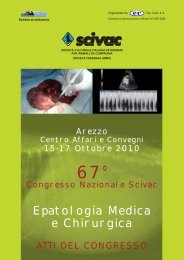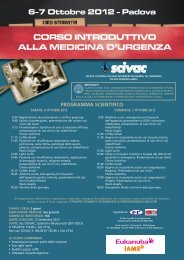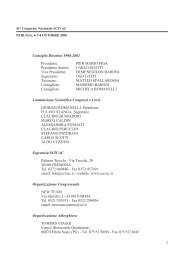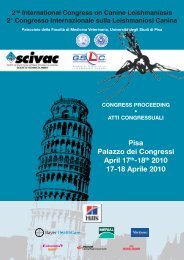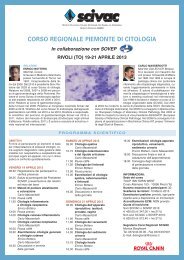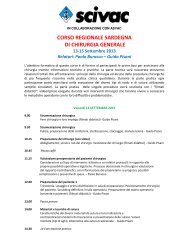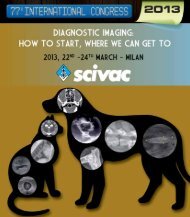58° Congresso Nazionale SCIVAC: Oncologia veterinaria
58° Congresso Nazionale SCIVAC: Oncologia veterinaria
58° Congresso Nazionale SCIVAC: Oncologia veterinaria
Create successful ePaper yourself
Turn your PDF publications into a flip-book with our unique Google optimized e-Paper software.
58° <strong>Congresso</strong> <strong>Nazionale</strong> <strong>SCIVAC</strong> • Milano, 7-9 Marzo 2008 • <strong>Oncologia</strong> <strong>veterinaria</strong> - Alle soglie del III Millennio<br />
Median remission and survival times were reported in dogs receiving this treatment<br />
after induction of remission by standard chemotherapy as compared to<br />
chemotherapy alone. Jeglum et al reported on the results of a trial for 214 dogs<br />
treated with MAb 231 after induction therapy with 2 cycles of VCAA (L-asparaginase,<br />
vincristine, cyclophosphamide, and doxorubicin). 80% of the dogs<br />
achieved a complete response after induction with VCAA. The dogs that achieved<br />
a complete remission then received 5 days of slow IV infusion of the monoclonal<br />
antibody. Median first remission duration was 125 days, with median<br />
survival of 448 days. 41% of dogs were alive at one year. This monoclonal antibody<br />
product is no longer commercially available, however.<br />
RELATIONSHIP OF CLASSIFICATION OF LYMPHOMAS<br />
AND RESPONSE TO THERAPY<br />
One reason for a lack of clear consensus as to the best treatment for<br />
lymphoma in dogs and cats is that this malignancy represents a number of different<br />
clinical manifestations with different biologic behaviors. Stage at diagnosis,<br />
histologic grade of malignancy, immunophenotype of lymphoma, and<br />
involvement of extranodal locations are all factors that must be considered<br />
when evaluating chemotherapy protocols for comparable remission and survival<br />
times. See the above discussion of prognostic factors for details.<br />
RADIATION THERAPY CONSIDERATIONS<br />
Lymphoma is generally exquisitely sensitive to radiation therapy. Thus, radiation<br />
therapy has a definite role in the treatment of lymphomas in veterinary<br />
medicine. Local lymphomas may be effectively treated in an emergency setting<br />
to restore vital organ function in the short term. Examples of this indication<br />
include life threatening anterior mediastinal lymphoma and CNS<br />
lymphoma. Lymphoma may also be treated with curative intent by radiation<br />
therapy. Examples of this indication include treatment of lymphoma of the nasal<br />
sinus cavity. Dogs and cats treated for nasal lymphoma with full course radiation<br />
therapy are likely to be cured of local disease. Unfortunately, systemic<br />
relapse is expected so sequential or concurrent treatment with chemotherapy<br />
is necessary for these patients. Lymphoma may be treated with radiation therapy<br />
as a salvage procedure, as in the case of treating single refractory sites<br />
such as resistant peripheral nodal disease. These remissions may be short lived<br />
for patients with end stage lymphoma, but patient benefit may be achieved<br />
in the short term. Finally, radiation can be used adjuvantly for treatment<br />
of systemic lymphoma.<br />
86



